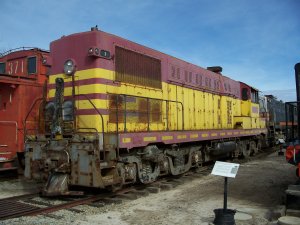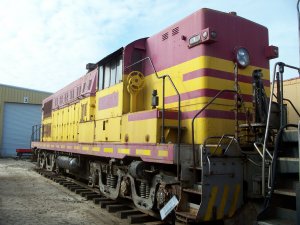 |
OREGON &
|
 |
 |
OREGON &
|
 |
The museum's heaviest locomotive has a turbocharged engine, dynamic brakes, staggered trucks, and was a restroom-equipped demonstrator.Built by Baldwin-Lima-Hamilton, Eddystone, PA; August 16, 1953
This big six-axle road switcher was the 134th unit of the 168 built in the 1950-54 Class AS-616 series, and was the first of the later style ones with roller bearings, different trucks, and higher hoods coming within two inches of the cab roof. "AS-616" means All Service, 6 motorized axles, 1600 horsepower. It weighs 325,000 lbs. (162.5 tons), over 35 tons more than any other museum locomotive. It's 58' long over coupler faces, 14' 1" high to the cab roof, and has 42" wheels in a C-C arrangement with Trimount trucks and roller bearings. The axles are staggered, with 5' 8 1/2" between the first and second axles from each end, and 7' 3 1/2" between the second and third axles. It has dynamic brakes, using the engine to help in braking, and is powered by an 8-cylinder turbocharged Baldwin Model 608A diesel engine (#6621) developing 1,600 hp. It has Westinghouse traction motors on all six axles, and tractive effort of 105,500 lbs. The left side of the long hood has a "bulge" under the stack, around the turbocharger.
Being the first of the new high-hood AS-616's, this unit was assigned as demonstrator and equipped with many "extras", including a toilet and washroom in the short hood, reached through a door in the cab on the fireman's side. It was painted yellow with red hood & cab tops, platform, and end stripes; silver end platforms and underframe; black railings & lettering; & yellow dashes on the platform sides. It was lettered with BLH and Westinghouse Electric & Manufacturing names, numbered BLH/WEM #1601 for its horsepower, and exhibited at the 1953 bi-annual Association of American Railroads summer convention in Atlantic City, NJ. Relettered BLH #1601, it was used in Wisconsin, Minnesota, and Michigan, and returned to Eddystone for winter storage.
Normally $145,000, it was sold at the discount price of $90,000 to the Oregon & Northwestern Railroad in the fall of 1954, relettered ONW #1 (retaining its demonstrator colors), and sent west with a one-day demonstration stop at the U.S. Steel plant in Geneva, Ut. On January 31, 1955 it began service on the ONW, a 51-mile logging line in the Silvies River area of east-central Oregon owned by the Hines Lumber Company and connecting with a UP branch at Burns, Or. The ONW had 2.6% maximum gradient, 12-degree maximum curvature, and 35 mph speed limit. ONW #l's restroom was removed when maintenance crews would not service it. After 30 years of service, it was placed in storage when the ONW closed down in 1985. UP's Burns branch became the Oregon Eastern Division of the Colorado & Wyoming Railroad.
In November 1990 ONW #1 was purchased with funds raised by the museum Board of Trustees, and moved from Burns to Ontario, Or. by the Oregon Eastern. Taken free of charge by UP, Santa Fe, & SD&IV to San Ysidro, Ca, in April 1991, it was brought to Campo July 12th by the SD&IV on "Great Freight IV". ONW #1 is still in BLH demonstrator colors with ONW lettering.
1992 Pacific Southwest Railway Museum Association. W. Schneider